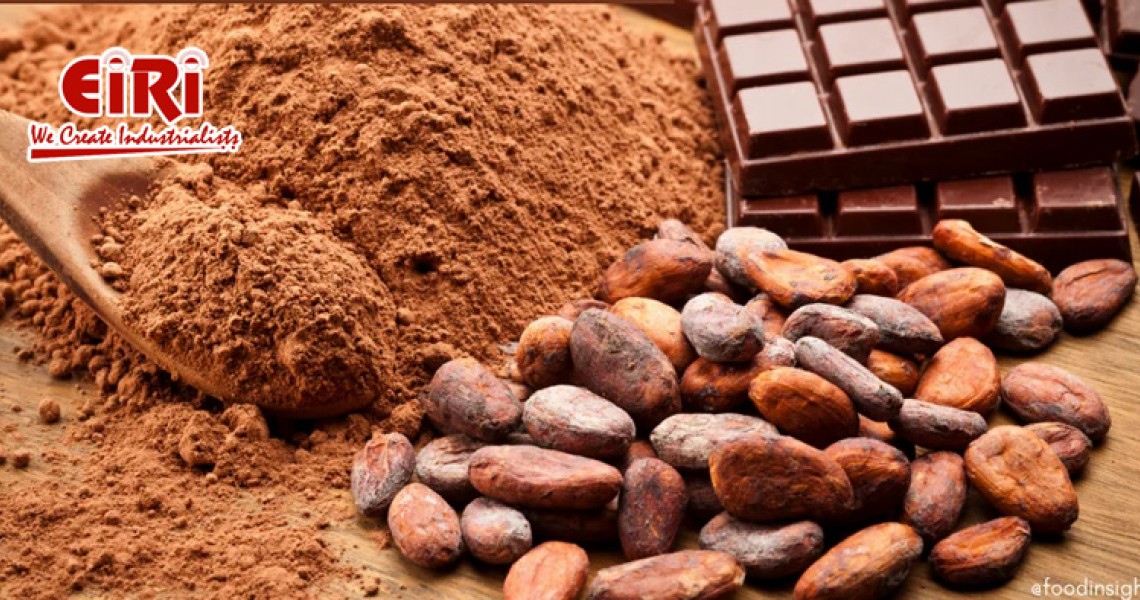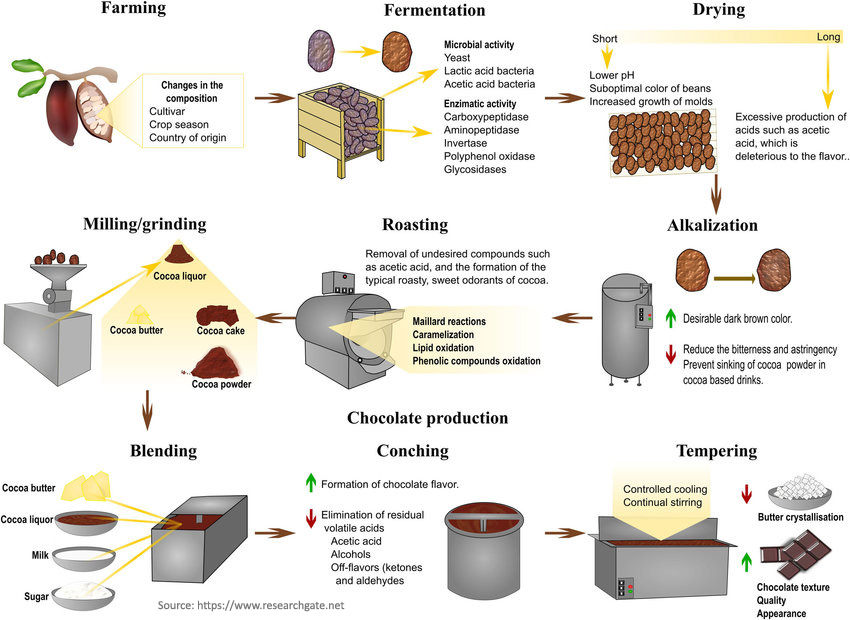Mastering the Chocolate Industry: A Primer for Cocoa Processing Entrepreneurs

Embarking on a journey into the world of cocoa processing can be both exciting and rewarding. As the demand for cocoa and cocoa-based products continues to rise globally, setting up a cocoa processing unit presents a promising business opportunity for entrepreneurs passionate about the chocolate industry. From sourcing high-quality cocoa beans to producing premium cocoa products, this guide offers valuable insights and practical tips for aspiring cocoa processors.
The global cocoa market reached USD 15.05 billion in 2022 and is projected to grow from USD 15.70 billion in 2023 to USD 21.98 billion by 2031, with a 4.3% CAGR from 2024-2031.
Cocoa processing involves a series of steps, from sorting to conching, to transform cocoa beans into cocoa butter, powder, and chocolate, delivering a rich taste experience. The global market thrives on the growing demand for chocolate, driven by consumer preference for premium varieties. Factors such as expanding food industry applications, rising disposable incomes, and technological advancements in processing machinery fuel market growth.
Opportunities abound in the confectionery sector, with innovative chocolate flavors gaining traction. Additionally, the popularity of functional and organic chocolates, coupled with demand from cosmetics and pharmaceuticals, spurs market expansion. The bakery and pastry sector, along with cocoa-based beverage trends, further propel market growth. Specialty chocolates for gifting and the use of cocoa powder in health products also contribute to market dynamics.
Understanding Cocoa Processing:
Cocoa processing involves a series of steps aimed at transforming raw cocoa beans into various cocoa products, including cocoa liquor, cocoa butter, cocoa powder, and chocolate. The process typically begins with the selection of premium cocoa beans sourced from cocoa-growing regions around the world. These beans are then subjected to rigorous cleaning, sorting, and roasting to develop their characteristic flavor profile.
Key Components of Cocoa Processing:
- Cleaning and Sorting: Raw cocoa beans are cleaned to remove extraneous matter such as dirt, stones, and other impurities. Sorting is then carried out to separate beans of different sizes and quality grades, ensuring uniformity and consistency in the final product.
- Roasting: Roasting is a critical step that enhances the flavor and aroma of cocoa beans. The beans are roasted at precise temperatures and durations to achieve the desired flavor profile, ranging from light and fruity to rich and intense. Proper roasting also helps remove moisture and volatile compounds, further enhancing the beans' flavor.
- Cracking and Winnowing: After roasting, the cocoa beans are cracked to separate the shell from the nib, the inner part of the bean containing cocoa solids and cocoa butter. Winnowing is then performed to remove the shell fragments, leaving behind clean cocoa nibs ready for further processing.
- Grinding and Refining: The cocoa nibs are ground into a fine paste known as cocoa liquor using specialized grinding equipment such as melangers or ball mills. This cocoa liquor serves as the primary ingredient for various cocoa products, including chocolate and cocoa powder. Further refining processes, such as conching, are carried out to improve texture and flavor.
- Pressing and Separation: Cocoa liquor can be pressed to extract cocoa butter, leaving behind a solid cake known as cocoa press cake. The cocoa butter is then refined and filtered to remove impurities, resulting in high-quality cocoa butter suitable for use in chocolate production or other applications.
- Milling and Packaging: Finally, cocoa liquor can be further processed into cocoa powder through milling and drying processes. The cocoa powder is then packaged into various formats, including bags, boxes, or bulk containers, ready for distribution to customers.

Growth Drivers for the Cocoa Processing Industry:
The cocoa processing industry is experiencing significant growth, driven by a confluence of factors that underscore its importance in the global marketplace. At the forefront of this growth is the soaring demand for chocolate products, fueled by a worldwide obsession with all things cocoa. From the bustling streets of urban metropolises to the quaint corners of rural towns, chocolate has become a beloved indulgence for people of all ages and backgrounds. This insatiable appetite for chocolate is not only driven by its irresistible taste but also by its ability to uplift moods and alleviate stress, making it a comforting treat in times of both celebration and solace. Moreover, as incomes rise and lifestyles evolve, consumers are increasingly drawn to premium chocolate offerings, including bars, truffles, and cocoa-based beverages, indulging in a diverse array of delectable delights.
Furthermore, cocoa's reputation as a health-enhancing superfood has propelled its popularity to new heights. In an era where wellness is paramount, consumers are turning to cocoa for its myriad health benefits. Rich in antioxidants, particularly flavonoids, cocoa is celebrated for its ability to boost cardiovascular health, enhance cognitive function, and mitigate the risk of chronic diseases. This growing awareness of cocoa's health benefits has sparked a surge in demand for products that offer both indulgence and nourishment. From dietary supplements to protein bars and functional foods, cocoa-infused products are capturing the attention of health-conscious consumers seeking convenient and nutritious options to support their well-being.
In addition to its health benefits, cocoa's versatility and appeal are further bolstered by continuous innovations in product development. Key industry players are pushing the boundaries of creativity, introducing new flavors, textures, and product variations to cater to evolving consumer preferences. Gourmet and artisanal chocolates, crafted from premium cocoa beans and featuring unique flavor profiles and visually appealing packaging, are captivating consumers seeking luxury indulgences. The allure of these premium chocolates transcends mere taste, embodying an experience that is both sensorial and sublime. As a result, consumers are willing to pay a premium price for these exquisite confections, driving market growth and profitability.
Moreover, cocoa's foray into the realm of skincare and beauty products adds another dimension to its market expansion. Recognized for its nourishing and rejuvenating properties, cocoa is increasingly incorporated into skincare formulations, offering consumers a natural and indulgent way to care for their skin. From moisturizers to masks and exfoliants, cocoa-infused skincare products are gaining popularity among beauty enthusiasts seeking products that deliver both efficacy and luxury.
The cocoa processing industry is thriving, propelled by a combination of factors including growing chocolate demand, awareness of cocoa's health benefits, and innovations in product development. As consumers continue to prioritize indulgence, wellness, and luxury, the cocoa market is poised for continued growth and innovation, offering opportunities for entrepreneurs and industry players alike to capitalize on this sweet and lucrative market segment.
1) Surge in Chocolate Demand:
The escalating demand for chocolate products worldwide is a key driver propelling market growth. With consumers increasingly indulging in chocolate delights, the market witnesses a surge in adoption, especially of premium chocolate offerings, supported by rising income levels. The availability of a diverse range of chocolate products, including bars, truffles, and cocoa-based beverages, further fuels market expansion. Additionally, the mood-enhancing and stress-relieving properties of chocolate contribute to its growing popularity.
2) Health Benefits of Cocoa:
Growing global awareness of health and wellness fuels market growth, with cocoa's natural health benefits taking center stage. Rich in antioxidants, notably flavonoids, cocoa aids in cardiovascular health improvement and cognitive function enhancement while reducing the risk of chronic diseases. As consumers prioritize health-conscious choices, products offering health benefits, including cocoa-infused dietary supplements, protein bars, and functional foods, witness increased demand, driving market growth.
3) Innovations in Cocoa Products:
Key industry players are driving market growth through continuous innovation, introducing new flavors, textures, and product variations to meet evolving consumer preferences. Gourmet and artisanal chocolates, crafted from high-quality cocoa beans and featuring unique flavor profiles and attractive packaging, resonate with consumers seeking premium indulgences. The allure of luxury chocolates prompts consumers to pay a premium price for these products. Moreover, cocoa's incorporation into skincare and beauty products further contributes to market expansion.
Market Opportunities and Challenges:
The global cocoa processing industry offers ample opportunities for growth and innovation, driven by increasing consumer demand for chocolate and cocoa-based products. However, establishing and operating a cocoa processing unit comes with its set of challenges, including:
- Supply Chain Management: Sourcing high-quality cocoa beans from reliable suppliers is crucial for ensuring product quality and consistency. Establishing strong relationships with cocoa farmers and cooperatives is essential for securing a steady supply of premium cocoa beans.
- Quality Control: Maintaining strict quality control measures throughout the processing chain is paramount to producing premium cocoa products. This includes monitoring factors such as bean quality, roasting parameters, grinding consistency, and final product specifications.
- Regulatory Compliance: Compliance with food safety regulations and industry standards is essential to ensure product safety and consumer trust. Cocoa processors must adhere to strict hygiene practices, labeling requirements, and quality assurance protocols to meet regulatory requirements.
- Market Dynamics: The cocoa processing industry is influenced by various market factors, including cocoa bean prices, consumer trends, and competitive pressures. Staying informed about market developments and adapting to changing consumer preferences is crucial for remaining competitive in the industry.
Conclusion:
Setting up a cocoa processing unit requires careful planning, investment, and dedication to quality. By understanding the intricacies of cocoa processing and staying attuned to market trends, entrepreneurs can capitalize on the growing demand for cocoa products and carve out a successful niche in the chocolate industry. With proper knowledge, expertise, and passion for cocoa, the journey from bean to bar can be both fulfilling and profitable for aspiring cocoa processors.










